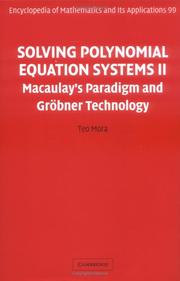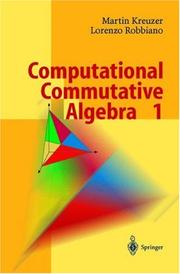| Listing 1 - 2 of 2 |
Sort by
|

ISBN: 9781107340954 9780521811569 1107340950 9781107266902 1107266904 9781299707610 1299707610 9781107269989 1107269989 9780521811545 0521811546 0521811562 9780521811552 0521811554 1139883003 1107266556 110726443X 1107263344 1107267978 9781139015998 Year: 2005 Volume: v. 99 Publisher: Cambridge Cambridge University Press
Abstract | Keywords | Export | Availability | Bookmark
 Loading...
Loading...Choose an application
- Reference Manager
- EndNote
- RefWorks (Direct export to RefWorks)
The second volume of this comprehensive treatise focusses on Buchberger theory and its application to the algorithmic view of commutative algebra. In distinction to other works, the presentation here is based on the intrinsic linear algebra structure of Groebner bases, and thus elementary considerations lead easily to the state-of-the-art in issues of implementation. The same language describes the applications of Groebner technology to the central problems of commutative algebra. The book can be also used as a reference on elementary ideal theory and a source for the state-of-the-art in its algorithmization. Aiming to provide a complete survey on Groebner bases and their applications, the author also includes advanced aspects of Buchberger theory, such as the complexity of the algorithm, Galligo's theorem, the optimality of degrevlex, the Gianni-Kalkbrener theorem, the FGLM algorithm, and so on. Thus it will be essential for all workers in commutative algebra, computational algebra and algebraic geometry.
Equations --- Polynomials. --- Iterative methods (Mathematics) --- Iteration (Mathematics) --- Numerical analysis --- Algebra --- Numerical solutions. --- Graphic methods --- Gröbner bases. --- Gröbner basis theory --- Commutative algebra

ISBN: 354067733X 3540255273 3540706283 3642064914 3540282963 9783540677338 9783540255277 Year: 2005 Publisher: Berlin, Heidelberg : Springer Berlin Heidelberg : Imprint: Springer,
Abstract | Keywords | Export | Availability | Bookmark
 Loading...
Loading...Choose an application
- Reference Manager
- EndNote
- RefWorks (Direct export to RefWorks)
Computational Commutative Algebra 2 is the natural continuation of Computational Commutative Algebra 1 with some twists, starting with the differently coloured cover graphics. The first volume had 3 chapters, 20 sections, 44 tutorials, and some amusing quotes. Since bigger is better, this book contains 3 chapters filling almost twice as many pages, 23 sections (some as big as a whole chapter), and 55 tutorials (some as big as a whole section). The number of jokes and quotes has increased exponentially due to the little-known fact that a good mathematical joke is better than a dozen mediocre papers. The main part of this book is a breathtaking passeggiata through the computational domains of graded rings and modules and their Hilbert functions. Besides Gröbner bases, we encounter Hilbert bases, border bases, SAGBI bases, and even SuperG bases. The tutorials traverse areas ranging from algebraic geometry and combinatorics to photogrammetry, magic squares, coding theory, statistics, and automatic theorem proving. Whereas in the first volume gardening and chess playing were not treated, in this volume they are. This is a book for learning, teaching, reading, and most of all, enjoying the topic at hand. The theories it describes can be applied to anything from children's toys to oil production. If you buy it, probably one spot on your desk will be lost forever!
Gröbner bases --- Commutative algebra --- Grobner, Bases de --- Algebre commutative --- Data processing --- Informatique --- Commutative algebra -- Data processing. --- Gröbner bases. --- Gröbner basis theory --- Mathematics. --- Computer science --- Algebra. --- Algebraic geometry. --- Computer mathematics. --- Algorithms. --- Computational Mathematics and Numerical Analysis. --- Symbolic and Algebraic Manipulation. --- Algebraic Geometry. --- Data processing. --- Algebra --- Geometry, algebraic. --- Algebraic geometry --- Geometry --- Computer mathematics --- Discrete mathematics --- Electronic data processing --- Algorism --- Arithmetic --- Mathematics --- Mathematical analysis --- Foundations --- Combinatorial analysis. --- QA 150-272 Algebra. --- Computer science—Mathematics. --- Group theory. --- Group Theory and Generalizations. --- Groups, Theory of --- Substitutions (Mathematics) --- Commutative algebra - Data processing --- Algebre commutative - Informatique
| Listing 1 - 2 of 2 |
Sort by
|

 Search
Search Feedback
Feedback About UniCat
About UniCat  Help
Help News
News